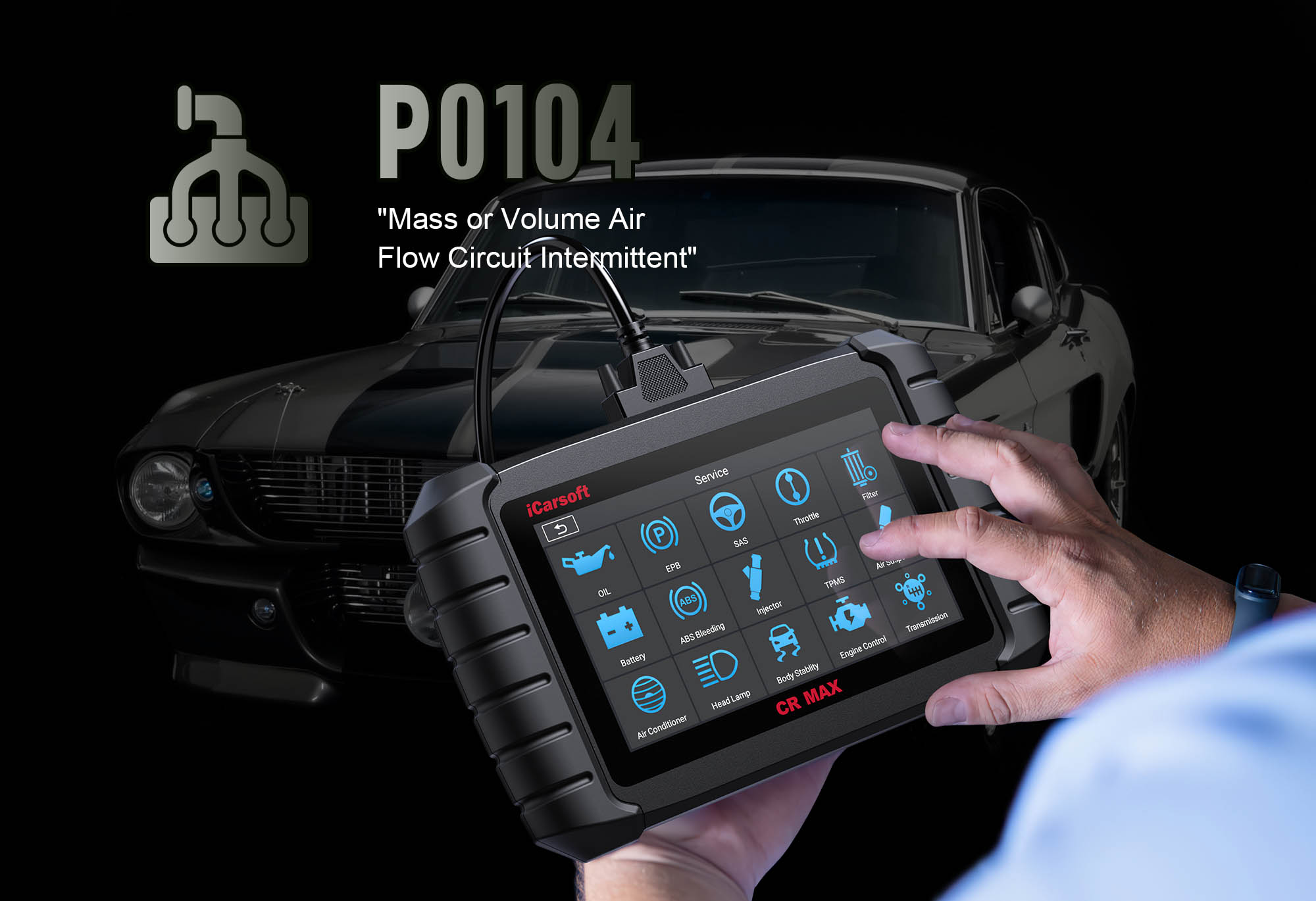Clear P0104 with iCarsoft CR MAX: Fix Mass Airflow Sensor Intermittent Issues
When your check engine light illuminates and a scan reveals P0104—"Mass Air Flow (MAF) Sensor Circuit Intermittent/Erratic"—you're dealing with a tricky issue that can cause unpredictable engine performance. Unlike clear-cut sensor failures, P0104 indicates intermittent electrical problems in the MAF sensor circuit, making it notoriously difficult to diagnose with basic tools.
The mass airflow sensor plays a critical role in your engine's performance, measuring the amount of air entering the engine to calculate proper fuel delivery. Intermittent issues with this sensor can lead to hesitation, rough idle, poor fuel economy, and even stalling—problems that come and go seemingly at random.
Fortunately, the iCarsoft CR MAX is equipped with specialized features to track down these elusive intermittent faults. Let's explore how to use this powerful diagnostic tool to identify, repair, and clear P0104 for good.
Understanding P0104: Why It's So Challenging
Before diving into diagnostics, let's clarify what P0104 means and why it's particularly frustrating:
The MAF Sensor's Role
Located in the intake system, the MAF sensor measures incoming air volume and density, sending this data to the Engine Control Module (ECM). The ECM uses this information to adjust fuel injection, ensuring optimal air-fuel mixture (typically 14.7:1 for gasoline engines). Without accurate MAF data, the engine can’t maintain efficient combustion—leading to performance issues.
What Triggers P0104
This code activates when the ECM detects irregular, fluctuating, or unexpected voltage signals from the MAF sensor circuit. Unlike P0100-P0103 (which indicate consistent circuit issues like "no signal" or "low voltage"), P0104 points to intermittent problems that may not be present during a standard diagnostic scan. For example, a loose wire might only cause a signal drop when the engine vibrates at a specific RPM—making it invisible during idle testing.
Common Symptoms of P0104
Intermittent Hesitation
Engine stumbles or lags during acceleration, then suddenly recovers—no consistent pattern.
Random Rough Idle
Idle fluctuates between 500–1,000 RPM sporadically, sometimes clearing up on its own.
Erratic Fuel Economy
MPG drops by 5–10% randomly, with no obvious cause (e.g., no change in driving habits).
Sudden Stalling
Engine shuts off unexpectedly, especially at idle or low speeds—often restarts normally afterward.
Fluctuating Check Engine Light
Light turns on for days, then off without repairs—signals intermittent fault recurrence.
Potential Causes of P0104
-
Loose/Corroded MAF Connectors: Oxidation on connector pins or loose terminals disrupt signal flow only when vibrated.
-
Frayed Wiring: Damaged insulation exposes wires, causing intermittent short circuits with nearby components.
-
Dirty MAF Sensor Elements: Oil residue or dust on hot wires/films causes irregular voltage readings (common in vehicles with oiled air filters).
-
Intermittent Sensor Failure: Internal electrical components in the MAF sensor degrade, leading to random signal drops.
-
ECM Software Glitches: Outdated ECM firmware misinterprets normal MAF fluctuations as erratic signals (fixed with updates).
-
Intake Air Leaks: Unmetered air entering post-MAF (e.g., cracked intake boot) causes inconsistent air-fuel ratios, triggering P0104.
Why iCarsoft CR MAX Excels at Diagnosing P0104
Intermittent issues like P0104 require more than basic scanning capabilities—they need tools that can "catch" faults in real time. The iCarsoft CR MAX addresses this with turbo-specific features tailored to elusive electrical problems:
Extended Data Logging
Captures MAF sensor data for hours (not just minutes) to record random fluctuations that basic scanners miss.
Advanced Signal Analysis
Visualizes MAF voltage waveforms to spot subtle irregularities (e.g., micro-spikes) that numerical data hides.
Customizable Threshold Alerts
Set triggers (e.g., "MAF voltage <0.5V for 0.5s") to auto-record when faults occur—no manual monitoring needed.
Built-In Multimeter
Tests circuit resistance, voltage, and continuity in one tool—eliminates need for separate meters during wiring checks.
Bi-Directional Controls
Activates the MAF sensor circuit manually to simulate conditions and force intermittent faults to appear.
Vehicle-Specific Libraries
Preloaded with OEM MAF voltage ranges (e.g., 0.8V–4.5V for Ford EcoBoost) and wiring diagrams for accuracy.
Step-by-Step: Diagnosing P0104 with iCarsoft CR MAX
-
Initial Code Reading & Verification
-
Plug the CR MAX into your vehicle’s OBD-II port (under the dashboard) and power it on.
-
Select your vehicle’s make/model/year via the menu or use AutoVIN (scans VIN automatically for precision—critical for MAF specs).
-
Navigate to Engine Control Module > Fault Codes > Read Codes to confirm P0104 is present.
-
Tap Code Details to view manufacturer-specific triggers (e.g., "MAF voltage fluctuation >1V in 0.3s" for Toyota Camry).
-
Check for related codes (e.g., P0171/P0174 for lean fuel mixture) to cross-reference MAF-related issues.
-
Monitor MAF Data in Real-Time
The first step to catching intermittent faults is watching MAF behavior as issues occur:
-
Go to Engine > Live Data > Air Intake System and select these parameters:
-
MAF Sensor Voltage (should stay stable at idle, rise smoothly with acceleration)
-
MAF Sensor Air Flow Rate (g/s or lb/min—varies by engine size)
-
Engine RPM
-
Short-Term Fuel Trim (STFT—should stay within ±10%)
-
Start the engine, let it reach operating temperature (5–10 minutes), then:
-
Monitor idle data for 5 minutes—look for random voltage drops/spikes.
-
Accelerate gently (1,500–3,000 RPM) and watch for MAF voltage "hesitation" (flat spots).
-
Use the Graph View to visualize trends—fluctuations are easier to spot than numbers.
-
Key Observation: If MAF voltage drops when the engine hesitates, the fault is active—note the RPM/condition for later testing.
-
Set Up Extended Data Logging
Since P0104 faults are random, use the CR MAX to record data over time until the issue reappears:
-
Navigate to Special Functions > Data Logging > Custom Log Setup.
-
Select the MAF parameters you want to track (include RPM and STFT for context).
-
Set Trigger Conditions to auto-start recording when:
-
MAF voltage goes outside normal range (e.g., <0.5V or >5V)
-
Voltage changes by >0.5V in less than 1 second (indicates erratic signal)
-
Set logging duration to 30+ minutes (CR MAX saves data to internal storage or USB).
-
Drive normally, noting when performance issues occur—log data will timestamp faults for later review.
-
Analyze MAF Waveforms
Waveform analysis reveals subtle issues (e.g., dirty sensor elements) that numerical data misses:
-
Go to Special Functions > Waveform Analysis > MAF Sensor.
-
Select Reference Library to pull up OEM waveform examples for your vehicle.
-
Compare your live waveform to the reference—look for these red flags:
-
Dropped Spikes: Voltage dips briefly (indicates loose connection).
-
Noise: Jagged waveform edges (signals dirty sensor or wiring interference).
-
Flat Spots: Voltage stops rising during acceleration (points to sensor failure).
-
Save the waveform to Data Storage for later reference (useful if you need to show a technician).
-
Test the MAF Sensor Circuit
If data points to wiring/connector issues, use the CR MAX’s multimeter to verify circuit health:
-
Turn off the engine, disconnect the MAF sensor connector (use CR MAX’s Component Location to find the sensor if needed).
-
Check Power Supply:
-
Set CR MAX to Multimeter > Voltage Test.
-
Connect probes to the "5V Reference" and "Ground" pins (refer to the CR MAX’s wiring diagram—e.g., Pin 2=5V, Pin 1=Ground for GM vehicles).
-
Turn ignition to "On" (no start)—normal voltage: 4.8V–5.2V. No voltage = damaged wiring or ECM issue.
-
Wiggle Test for Intermittent Breaks:
-
Set to Multimeter > Continuity Test, connect probes to the MAF signal pin and ECM signal pin (use wiring diagram).
-
Gently wiggle the wiring harness along its length—if continuity cuts in/out, there’s a frayed wire.
-
Inspect Connectors: Use the CR MAX’s built-in flashlight to check for corroded/bent pins—clean with electrical contact cleaner if needed.
-
Clean or Test the MAF Sensor
Dirt or internal failure often causes P0104—use the CR MAX to guide repairs:
-
If Waveforms Show Noise (Dirty Sensor):
-
Use the CR MAX’s Maintenance Guides to locate the MAF sensor (typically in the intake tube after the air filter).
-
Remove the sensor, spray with specialized MAF cleaner (never use brake cleaner), and let dry 10–15 minutes.
-
Reinstall and recheck live data—noise should disappear if dirt was the issue.
-
If Sensor Is Suspected Faulty:
-
Set CR MAX to Multimeter > Resistance Test.
-
Connect probes to the MAF sensor’s signal and ground pins (refer to Sensor Specs for your vehicle).
-
Normal resistance: 1,000–3,000 ohms (varies by make/model). Out of range = faulty sensor (replace with OEM).
Clear P0104 & Verify Repairs
After fixing the root cause (e.g., cleaning the sensor, repairing wiring), use the CR MAX to ensure P0104 doesn’t return:
-
Reconnect all components (MAF sensor, connectors, intake hoses).
-
Clear the Code: Go to Fault Codes > Clear Codes, select P0104, and confirm deletion.
-
ECM Reset: Navigate to Special Functions > Engine > ECM Relearn—this clears old, faulty MAF data and resets fuel trim values.
-
Post-Repair Verification Test:
-
Run the CR MAX’s Auto Test > Engine System Test—it automatically checks MAF voltage stability for 10 minutes.
-
Take an extended test drive (30+ minutes) with Data Logging enabled—include highway and city driving to replicate real conditions.
-
Re-scan after driving:
-
No P0104 + stable MAF voltage = fix successful.
-
Code returns = double-check for hidden issues (e.g., cracked intake boot, failing ECM).
Preventing Future P0104 Issues
Use the CR MAX to keep intermittent MAF problems at bay:
-
Monthly MAF Health Checks: Run Special Functions > Sensor Tests > MAF Sensor Check to monitor voltage stability.
-
Air Filter Maintenance: Replace non-oiled air filters every 15,000 miles (oiled filters can contaminate MAF elements—avoid if possible).
-
Set Custom Alerts: Use the CR MAX to notify you if MAF voltage fluctuates beyond normal ranges (catches early issues).
-
ECM Firmware Updates: Check Special Functions > Vehicle Info > TSB Lookup for manufacturer bulletins about MAF-related software fixes.
-
Annual Wiring Inspections: Use the CR MAX’s continuity test to check MAF circuit health—prevent frayed wires from causing future faults.
Conclusion
P0104’s intermittent nature makes it one of the most frustrating engine codes to diagnose—but the iCarsoft CR MAX turns guesswork into precision. With its extended logging, waveform analysis, and built-in testing tools, the CR MAX doesn’t just "read" P0104—it catches the fault in action, whether it’s a loose wire, dirty sensor, or failing component.
For both DIYers and technicians, this means avoiding unnecessary MAF sensor replacements (a common mistake with P0104) and fixing the real issue the first time. By combining professional-grade diagnostics with user-friendly controls, the iCarsoft CR MAX ensures your engine runs smoothly—and keeps P0104 in the rearview mirror.





